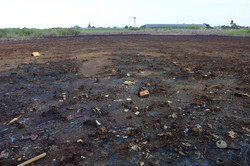NANOREM: early results confirm the potential of nanoparticles for soil and water remediation
Despite its positive impact on quality of life, industrialisation has left many polluted sites in its wake. Every year EUR 6 billion is spent to manage these sites in Europe. In the meantime, the surface area of polluted soils is expected to increase by 50 % by 2025 according to a report issued by the European Environment Agency in 2012. Additionally, the EU estimates that 20 % of European water is seriously threatened by pollution. Whereas most countries currently rely on ‘pump and treat’ and/or removal to landfill (ex situ techniques) to remediate soil and water, the excavation of contaminated material can sometimes be either not desirable or not feasible. This is where in situ technologies – biological, chemical, physical and/or thermal processes to treat soil and/or groundwater at sub-surface level – come into play: they can be undertaken with minimal disruption in site operations, they reduce worker exposure to a minimum and they have a much smaller footprint than ex situ methods. Aiming to bring in situ techniques to the next level, the NANOREM project trusts in the use of small particle size and high reactivity nanoparticles. Nano-scale zero valent iron (nZVI), for example, is expected to deliver a substantial improvement in remediation performance for a wide range of problems. The use of these nanoparticles, however, is limited due to uncertainties surrounding their environmental impact. Encouraging results The project has five core objectives, one of which is increased knowledge and confidence among stakeholders. To achieve this, the team has been measuring the toxicity of potentially interesting nanoparticles, assessing their ecotoxicity when in contact with soil and pollutants, measuring how this toxicity changes with time, and describing how they interact with indigenous microorganisms during and after remediation treatment. Recently, the NANOREM team announced the initial results of ecotoxicological tests for a range of nanoparticles that could be good candidates for remediation projects: NanoFer 25S, Carbo-Iron, Fe-Oxide, Fe-Zeolites and Bionanomagnetite. The nanoparticles were tested on a range of organisms including earthworms, crustacean, green algae and bacteria, and the team found no significant toxicological effects on either of them. The team has also announced two other positive findings. First they confirmed that, while looking at how nanoparticles’ reactivity and toxicity changes with time, they actually become less reactive as they interact with soil matrices. Then, they investigated whether nanoparticles being used to treat pollutants were able to fully degrade them and not to turn them into more toxic compounds – a widespread concern among stakeholders. Although this work is still underway, initial results seem to indicate no increase in pollutant toxicity even within a few metres of the injection wells and shortly after the injection was performed. On the contrary, groundwater samples from one of the field sites were found to be highly toxic prior to injection of Fe-Oxide nanoparticles, but this toxicity was significantly reduced within three weeks following injection. The project will continue until January 2017, when the team hopes to have low-cost production techniques ready for use in large-scale commercial applications. The next steps will be to pursue ecotoxicity testing, whilst the monitoring of injected field sites will continue for several months and assays on microbial functioning are scheduled for the second half of the project. The researchers are optimistic and consider the results obtained thus far as extremely promising. For further information, please visit: NANOREM http://www.nanorem.eu/(opens in new window)
Countries
Germany



